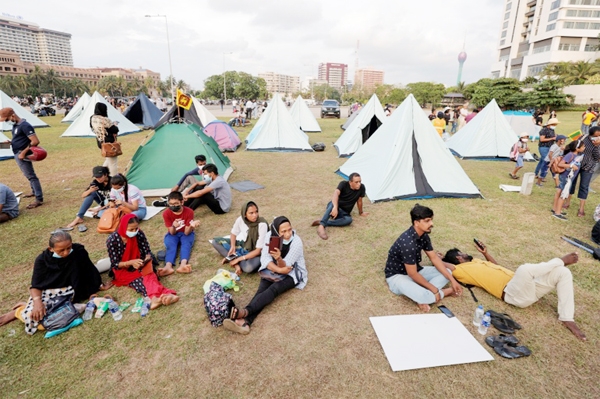
Al Jazeera :
Angry over a worsening economic crisis, residents of Sri Lanka’s capital, Colombo, have transformed the streets in front of President Gotabaya Rajapaksa’s office into a protest camp.
Hundreds have stayed put there since Saturday despite bouts of heavy rain, saying they will not leave until the president and his powerful brothers resign.
The waterfront area, known as the Galle Face Green, is home to some of Colombo’s most expensive hotels, including the Shangri-La and the Kingsbury. Now, dozens of colourful tents, many filled with donations to sustain protesters, occupy its lawns and streets.
There are tents for food and water, and others for medicine. Portable toilets have also been brought in.
On Thursday, a carnival atmosphere prevailed as a truck carrying huge loudspeakers parked in front of the presidential secretariat blared protest slogans and music, including the now-famous chant: “Go home, Gota.”
A group of women handed out steaming cups of kottamalli – a herbal brew – from a large pot on a fire on one corner, as vendors selling ice cream and paan, a mix of betel leaves and areca nut, worked their way through the crowds.
Tents at a protest area where people are gathering in opposition to Sri Lanka’s President Gotabaya Rajapaksa in Colombo [Dinuka Liyanawatte/ Reuters]
Men, women and children – from Sri Lanka’s various ethnic and religious groups – milled about, waving the country’s golden lion flag, chanting slogans and holding up placards with hand-written messages. Two young men carried boards that said: “This will end when we see all of you in jail” and “We are not here to have fun. We are here to take our country back.”
Another woman’s placard said: “This is the beginning of a new civilisation. Proud to be Sri Lankan.”
“The energy here, I’ve never felt anything like it,” said protester Andy Schubert, as he looked on at the crowds shouting anti-government slogans. “It’s so inspiring.”For many people on Galle Face Green, this was their first-ever protest.
After months of enduring power cuts and queues for fuel and cooking gas, the protesters said their patience had been pushed to the limits by the Rajapaksa government’s refusal to acknowledge the severity of their economic pain as well as its inability to chart a path forward.
The crisis, sparked by a foreign exchange crunch, has resulted in soaring inflation as well as shortages of diesel, petrol and medicines.
No Sri Lankan, rich or poor, has been spared its effects.
Colombo’s residents first began protesting in early March with small gatherings in their various neighbourhoods. One such rally outside the president’s house on March 31 devolved into violence, prompting Rajapaksa to declare a state of emergency and a curfew. But that only led to more protests in the capital and in and other cities.
In a bid to placate the anger, Rajapaksa rescinded the emergency measures and sacked his brother as finance minister. He also appointed a well-respected economist as the governor of the Central Bank ahead of bailout talks with the International Monetary Fund (IMF).
“One fasting Muslim woman carried a placard addressing the president, saying “You divided us to come to power. Now we are uniting to send you home.”
Analysts said the spontaneous and leaderless protests at the Galle Face Green mark the emergence of a political movement that is not based along religious and ethnic lines – a first in modern Sri Lankan history.
“Sri Lanka’s economic collapse, and the anger it has generated, have given rise to a protest movement that is so large, so sustained and so widespread that it can be called a non-violent people’s uprising,” said Alan Keenan, senior consultant at the Washington, DC-based International Crisis Group.

